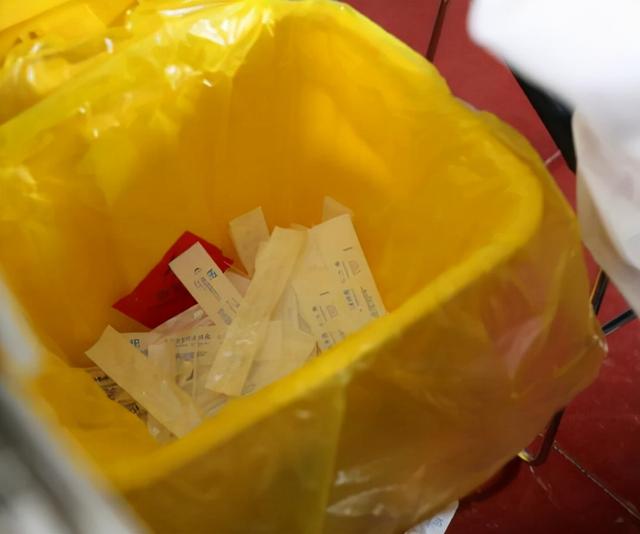Negli ospedali, tamponi sono uno strumento fondamentale per la raccolta dei campioni, controllo delle infezioni, e test diagnostici. Tuttavia, La gestione dei rifiuti dei tamponi è una questione complessa che le strutture sanitarie devono affrontare per garantire sia la sostenibilità ambientale che la sicurezza dei pazienti. Lo smaltimento dei tamponi e degli altri rifiuti sanitari è regolato da rigide linee guida per ridurre al minimo la contaminazione e prevenire la diffusione di infezioni. Ecco una panoramica di come gli ospedali gestiscono i rifiuti dei tamponi:

L'importanza di un corretto smaltimento dei tamponi
Tamponi, compresi i tamponi di cotone, tamponi di schiuma, e tamponi floccati, sono utilizzati in una vasta gamma di procedure mediche. Dopo l'uso, sono spesso contaminati da fluidi corporei, agenti patogeni, o prodotti chimici. Lo smaltimento improprio dei rifiuti dei tamponi può portare alla contaminazione incrociata, la diffusione delle infezioni, e rischi ambientali. Gli ospedali devono aderire alle linee guida stabilite dalle autorità sanitarie e dalle agenzie di protezione ambientale per garantire una manipolazione sicura, disposizione, e il riciclaggio di questi materiali.
Fare un passo 1: Categorizzazione dei rifiuti sanitari
Uno dei primi passi che gli ospedali intraprendono nella gestione dei rifiuti dei tamponi è classificare correttamente i rifiuti. I rifiuti dei tamponi rientrano nella categoria dei “rifiuti sanitari regolamentati” (RMW) a causa del suo potenziale di infezione. I rifiuti sanitari sono generalmente classificati nelle seguenti categorie:
- Rifiuti infettivi: Ciò include i tamponi utilizzati per la raccolta di campioni o per la cura delle ferite e contaminati con fluidi corporei o agenti patogeni.
- Rifiuti taglienti: Sebbene i tamponi stessi non siano taglienti, possono essere contaminati da aghi o altri oggetti appuntiti e vengono smaltiti di conseguenza.
- Rifiuti non infettivi: Alcuni tamponi possono essere contaminati con sostanze non infettive e sono classificati come non pericolosi.
Classificando correttamente i rifiuti, gli ospedali garantiscono che ogni tipologia di rifiuto venga smaltita nel modo appropriato.
Fare un passo 2: Smaltimento sicuro e separazione
Una volta raccolti i rifiuti del tampone, è suddiviso in codici colore, contenitori a tenuta stagna conformi ai requisiti normativi locali per i rifiuti sanitari. Nella maggior parte degli ospedali, viene utilizzato un sistema di separazione dei rifiuti a tre livelli:
- Contenitori rossi: Per rifiuti infetti, come i tamponi utilizzati nei test per virus o infezioni batteriche.
- Contenitori gialli: Per rifiuti sanitari generici che potrebbero non essere infettivi ma che necessitano comunque di essere maneggiati con cura.
- Contenitori taglienti: Per aghi usati e oggetti appuntiti che potrebbero essere entrati in contatto con i tamponi.
Ogni contenitore per rifiuti è sigillato ermeticamente per evitare perdite e ridurre al minimo il rischio di infezione. Anche gli ospedali si avvalgono di personale specializzato, sacchetti per materiali a rischio biologico per contenere tamponi usati e altri materiali di scarto prima che vengano trasportati nelle aree di smaltimento.
Fare un passo 3: Metodi di trattamento e smaltimento
I rifiuti dei tamponi vengono generalmente sterilizzati e trattati per garantire che siano esenti da agenti infettivi. I due metodi principali per il trattamento dei rifiuti sanitari sono:
- Autoclavaggio: Il metodo più comune per il trattamento dei rifiuti infetti, l'autoclavaggio utilizza vapore sotto pressione per sterilizzare i rifiuti. Il calore elevato garantisce che eventuali agenti patogeni presenti sui tamponi vengano distrutti prima che vengano inviati allo smaltimento finale.
- Incenerimento: In alcuni casi, i rifiuti sanitari vengono inceneriti ad alte temperature per garantire la completa distruzione dei microrganismi dannosi. Questo metodo è particolarmente efficace per i rifiuti che non possono essere autoclavati.
Dopo la sterilizzazione, i rifiuti trattati vengono inviati in una discarica o in un impianto di riciclaggio, a seconda della natura dei rifiuti. Gli ospedali stanno adottando sempre più pratiche rispettose dell’ambiente, come ridurre la quantità di rifiuti non riciclabili che generano, e alcuni tamponi possono essere riciclati dopo la sterilizzazione.
Fare un passo 4: Riciclaggio e sostenibilità
Negli ultimi anni, molti ospedali si sono rivolti a pratiche di gestione dei rifiuti più sostenibili, Compreso il riciclaggio e il ritrattamento di alcuni articoli medici. Mentre il riciclaggio degli stessi tamponi potrebbe non essere possibile a causa della contaminazione, Alcuni materiali associati ai rifiuti di tampone, come imballaggi e componenti di plastica, può essere riciclato. Gli ospedali stanno investendo in tecnologie di scarico a energia e opzioni di smaltimento sostenibile per ridurre il loro impatto ambientale.
Inoltre, produttori medici stanno producendo tamponi e altri materiali di consumo realizzati con materiali biodegradabili o ecologici per mitigare la quantità di rifiuti non riciclabili generati. Gli ospedali possono anche ridurre la propria impronta ambientale ottimizzando la gestione dell'inventario e riducendo l'uso inutile di tamponi monouso.
Fare un passo 5: Formazione e conformità del personale
Una gestione efficace dei rifiuti inizia con personale sanitario ben addestrato. Gli ospedali forniscono formazione a tutto il personale coinvolto nella gestione e nello smaltimento dei rifiuti sanitari, assicurandosi che comprendano l'importanza dei protocolli di sicurezza e della corretta separazione dei rifiuti. Anche gli ospedali rispettano le normative locali, stato, e le normative nazionali per ridurre al minimo il rischio di esposizione a malattie infettive e contaminazione ambientale.
Conclusione
Gli ospedali devono gestire con attenzione i rifiuti dei tamponi per proteggere sia la salute pubblica che l’ambiente. Seguendo rigidi protocolli di categorizzazione, smaltimento di, e il trattamento dei rifiuti sanitari, le strutture sanitarie riducono al minimo i rischi associati allo smaltimento dei tamponi. Mentre gli ospedali continuano ad abbracciare la sostenibilità, le pratiche di gestione dei rifiuti si evolveranno per soddisfare sia le esigenze sanitarie che gli obiettivi ambientali.

















